Simple Sensory Activities for an Autistic Teenager
Discover engaging sensory activities for autistic teens, promoting exploration and self-expression in a supportive environment.

Understanding Sensory Exploration for Autistic Teens
Sensory exploration plays a crucial role in the development and well-being of autistic teens. Engaging in sensory activities provides them with opportunities to explore their senses, enhance their sensory processing skills, and promote overall sensory integration. Understanding the importance of sensory activities and the benefits they offer can help create a supportive environment for autistic teens.
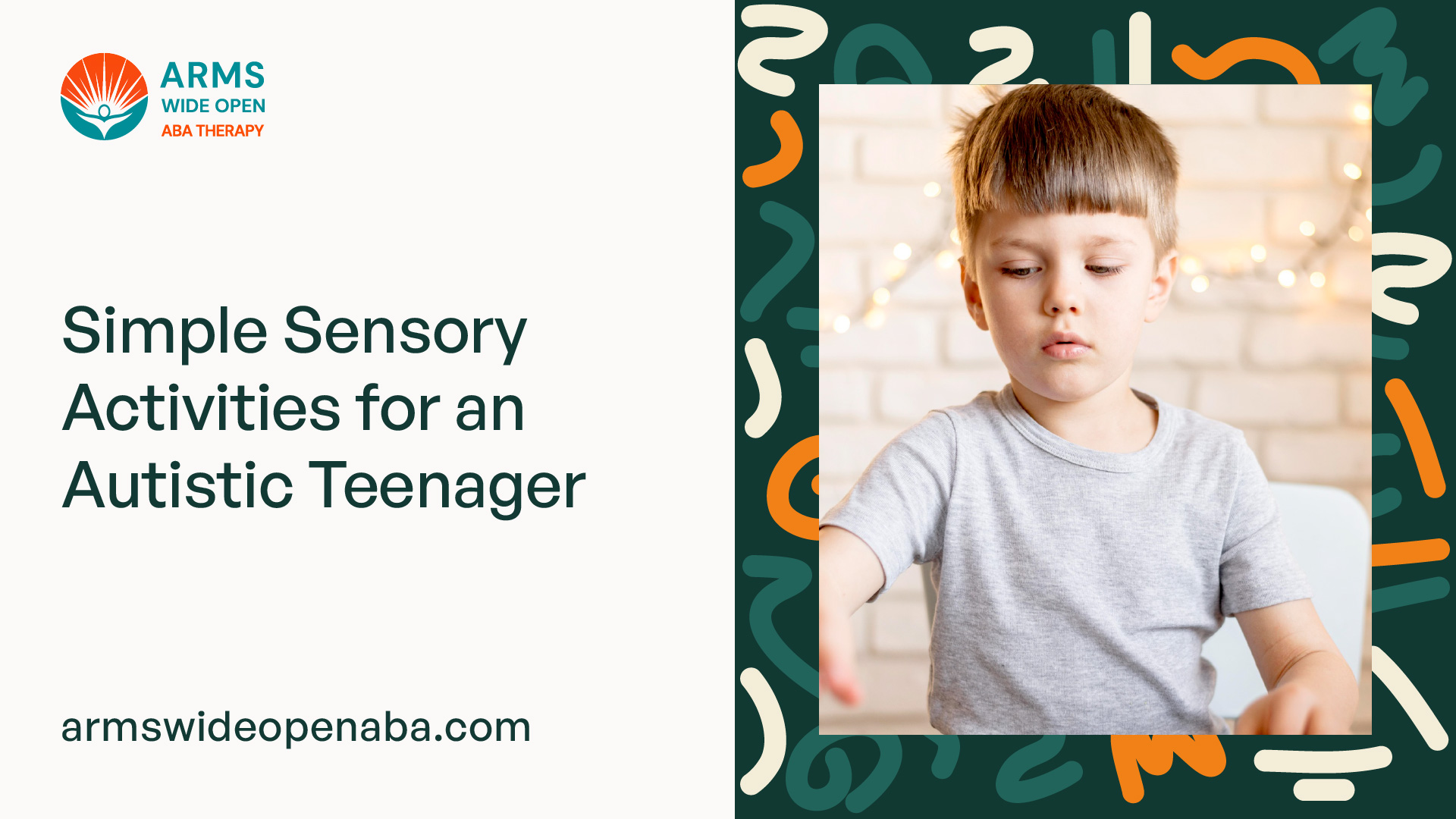
Importance of Sensory Activities
Sensory activities are vital for autistic teens as they provide a means of self-regulation and self-expression. Engaging in sensory exploration allows them to experience and understand different sensory inputs, such as touch, smell, sight, sound, and taste. These activities help autistic teens develop their sensory processing abilities, which are often affected by their neurological differences.
By providing a structured and controlled environment for sensory experiences, autistic teens can learn to manage sensory overload, improve their concentration, and develop emotional regulation skills. Sensory activities also facilitate the development of fine motor skills, coordination, and body awareness.
Benefits for Autistic Teens
Engaging in sensory exploration offers numerous benefits for autistic teens. These activities can:
- Promote relaxation and stress reduction: Sensory activities provide a calming effect and help reduce anxiety and stress levels in autistic teens.
- Enhance sensory processing skills: By actively engaging in sensory experiences, autistic teens can improve their ability to process and respond to sensory information more effectively.
- Support cognitive and language development: Sensory activities stimulate cognitive functioning, language skills, and learning abilities in autistic teens.
- Facilitate self-expression and communication: Sensory exploration allows autistic teens to express themselves non-verbally, facilitating communication and self-expression.
- Develop social skills: Participating in sensory activities in group settings can promote social interaction, cooperation, and turn-taking skills.
- Improve body awareness and coordination: Sensory activities help autistic teens develop a better understanding of their bodies and improve their coordination and motor skills.
Understanding the importance and benefits of sensory activities for autistic teens is essential for creating a supportive and enriching environment. By incorporating these activities into their daily lives, caregivers and educators can help autistic teens thrive and reach their full potential.
Creating a Sensory-Friendly Environment
When it comes to engaging in sensory activities, creating a sensory-friendly environment is essential for autistic teenagers. This environment should be designed to be safe, comfortable, and conducive to sensory exploration. In this section, we will explore two key aspects of creating a sensory-friendly environment: designing a safe and comfortable space and utilizing different sensory tools.
Designing a Safe and Comfortable Space
Designing a safe and comfortable space is the first step in creating a sensory-friendly environment for autistic teenagers. Here are some considerations to keep in mind:
- Safety: Ensure that the space is free from potential hazards, such as sharp objects or loose wires. Remove any items that may pose a risk to the teenager's physical well-being.
- Comfort: Make the space comfortable by incorporating elements that promote relaxation and calmness. Consider using soft lighting, comfortable seating options, and cozy textures such as cushions or blankets.
- Organization: Keep the space well-organized and clutter-free. This can help reduce sensory overload and provide a sense of order and predictability.
- Personalization: Allow the teenager to personalize the space according to their preferences. This can include displaying artwork, photographs, or objects that hold special meaning to them.
Remember that each autistic teenager may have different sensory needs and preferences. It's important to consult with the individual and their caregivers to create a space that caters to their specific requirements.
Utilizing Different Sensory Tools
In addition to designing a safe and comfortable space, utilizing different sensory tools can enhance the sensory experience for autistic teenagers. Here are some examples of sensory tools that can be incorporated:
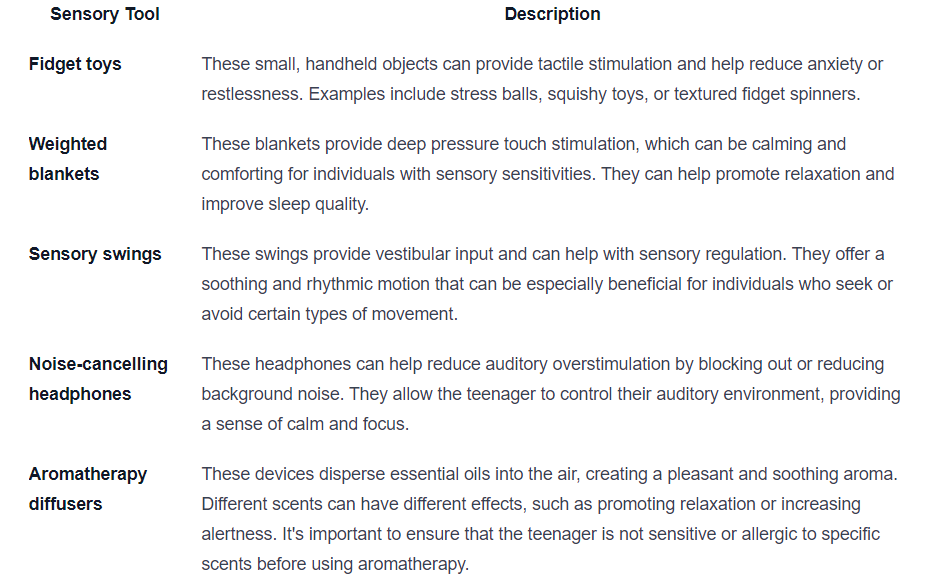
By utilizing different sensory tools, you can cater to the unique sensory needs of autistic teenagers and create an environment that supports their well-being and sensory exploration. It's important to regularly assess and adjust the sensory tools based on the teenager's preferences and feedback to ensure their comfort and engagement.
Simple Sensory Activities
Engaging in sensory activities can provide valuable stimulation and enjoyment for autistic teenagers. Here are some simple sensory activities that can be incorporated into their daily routine:
Texture Exploration
Texture exploration activities can help autistic teenagers develop their tactile senses and promote sensory integration. These activities involve exposing them to different textures and allowing them to explore and interact with various materials.
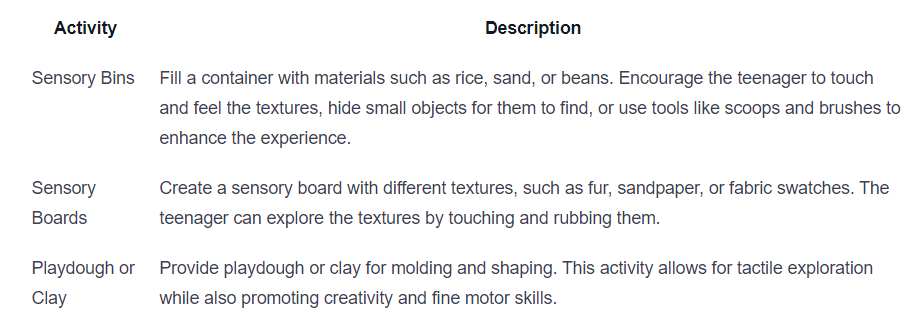
Aromatherapy and Scents
Aromatherapy and scents can have a calming and soothing effect on autistic teenagers. Introducing pleasant scents can help create a relaxing environment and promote sensory well-being.
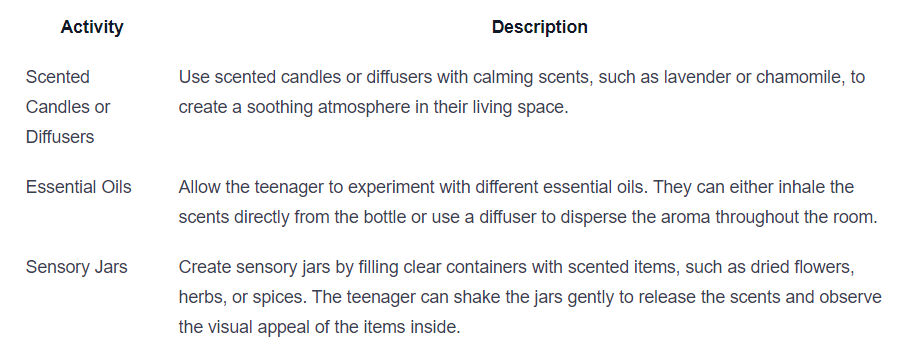
Visual Stimulation
Visual stimulation activities can be engaging and enjoyable for autistic teenagers, as they often have a heightened sensitivity to visual stimuli. These activities can help them focus, relax, and explore the world visually.
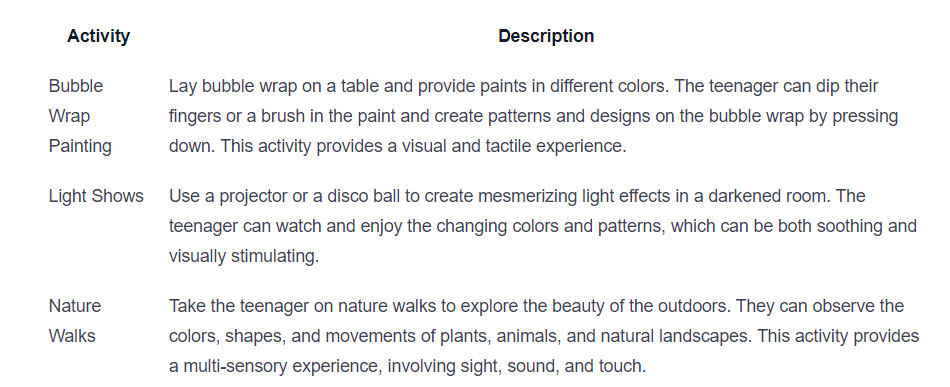
By incorporating these simple sensory activities into the daily life of an autistic teenager, you can provide them with opportunities for sensory exploration, relaxation, and self-expression. It's important to observe their individual preferences and adapt the activities to suit their specific sensory needs and sensitivities.
Engaging the Senses
Engaging the senses through various activities can be a valuable experience for autistic teenagers. By incorporating sensory elements into their daily lives, they can explore and interact with their environment in a meaningful way. In this section, we will explore three sensory areas: sound and music, movement and physical activities, and taste and food exploration.
Sound and Music
Sound and music can have a profound impact on sensory experiences for autistic teenagers. Engaging with different sounds and rhythms can help promote relaxation, focus, and self-expression. Here are some simple activities that can be incorporated:
- Listening to calming music or nature sounds, which can have a soothing effect on the individual.
- Exploring different musical instruments, allowing them to experiment with creating their own sounds.
- Participating in music therapy sessions, which can provide a structured and therapeutic approach to sensory engagement.
Movement and Physical Activities
Physical activities that involve movement can provide sensory input and help regulate the sensory system of autistic teenagers. These activities can contribute to their overall well-being and support their sensory needs. Here are some examples:
- Engaging in activities like yoga or tai chi, which promote relaxation, body awareness, and self-control.
- Participating in dance classes or rhythmic movement activities, which can provide a structured and expressive outlet for sensory exploration.
- Using sensory equipment like swings, trampolines, or balance boards, which can provide proprioceptive and vestibular input.
Taste and Food Exploration
Food can be a sensory experience that offers exploration and self-discovery for autistic teenagers. Engaging with different tastes, textures, and aromas can help develop their sensory preferences and expand their food choices. Here are some suggestions:
- Introducing new foods gradually, allowing them to explore different tastes and textures at their own pace.
- Encouraging involvement in meal preparation, which can provide a sensory-rich experience and promote independence.
- Incorporating sensory-focused activities like taste testing, cooking classes, or sensory-based food play sessions.
By engaging the senses through sound and music, movement and physical activities, and taste and food exploration, autistic teenagers can enhance their sensory experiences and find enjoyment in their daily lives. It's important to personalize and adapt these activities based on individual preferences and sensitivities, ensuring a positive and meaningful sensory exploration journey.
Tailoring Activities for Individual Needs
When it comes to engaging in sensory activities, it's important to understand that each autistic teenager is unique and may have specific sensory preferences and sensitivities. By tailoring activities to meet their individual needs, you can create a more enjoyable and beneficial experience. Here are two key aspects to consider when customizing sensory activities for autistic teens: understanding sensory preferences and adapting activities for sensory sensitivities.
Understanding Sensory Preferences
To effectively tailor sensory activities, it's essential to have a good understanding of an autistic teen's sensory preferences. Some individuals may have a heightened sensitivity to certain sensory inputs, such as touch or sound, while others may seek out specific sensory experiences. By observing and communicating with the autistic teenager, you can gain insights into their sensory preferences.
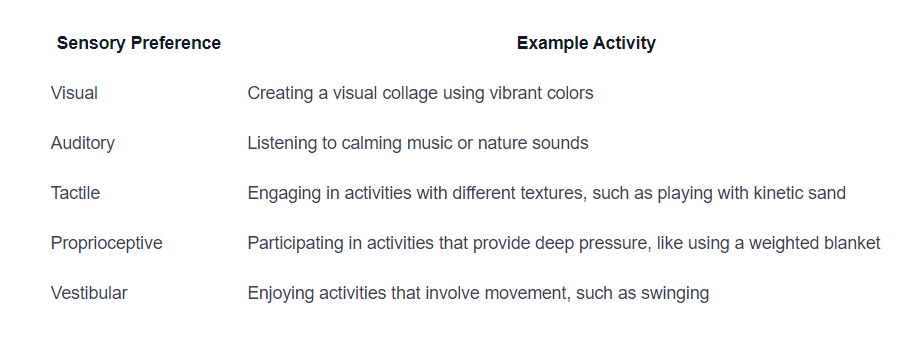
Understanding an autistic teen's sensory preferences allows you to select activities that align with their interests and provide them with a positive sensory experience.
Adapting Activities for Sensory Sensitivities
In addition to understanding sensory preferences, it's crucial to adapt activities to accommodate sensory sensitivities. Autistic teenagers may have sensitivities to certain sensory inputs, which can cause discomfort or overwhelm. By making necessary adaptations, you can ensure that the activities are enjoyable and accessible for them.

By adapting activities based on sensory sensitivities, you can create a safe and comfortable environment that promotes engagement without causing sensory overload or distress.
When tailoring activities for autistic teenagers, remember that communication and flexibility are key. Regularly check in with the individual, listen to their feedback, and make adjustments as needed. By understanding their sensory preferences and sensitivities, and adapting activities accordingly, you can create a positive and beneficial sensory exploration experience for autistic teenagers.
Incorporating Sensory Activities into Daily Life
To maximize the benefits of sensory activities for autistic teenagers, it is important to integrate them into their daily routines. By establishing consistent routines and encouraging self-expression through sensory exploration, parents and caregivers can create a supportive environment that promotes overall well-being.
Establishing Routines
Establishing regular routines can provide a sense of structure and predictability for autistic teenagers. Routines help create a stable and comfortable environment that allows them to feel secure and in control. When incorporating sensory activities into daily life, consider the following:
- Schedule: Create a daily schedule that includes dedicated time for sensory activities. This can help the teenager anticipate and prepare for these activities, reducing anxiety and increasing engagement.
- Consistency: Stick to the established routine as much as possible. Consistency helps build a sense of familiarity and allows the teenager to feel more comfortable and relaxed.
- Visual Supports: Use visual aids such as visual schedules or picture symbols to enhance understanding and communication. Visual supports can help the teenager navigate through the daily routine and provide a visual reminder of upcoming sensory activities.
Encouraging Self-Expression through Sensory Exploration
Sensory exploration can be a powerful tool for self-expression and communication for autistic teenagers. Encouraging self-expression through sensory activities allows them to engage with their environment in a way that feels comfortable and meaningful. Here are some strategies to consider:
- Choice and Autonomy: Offer a variety of sensory activities and allow the teenager to choose what interests them the most. By giving them control over their sensory experiences, it promotes independence and self-advocacy.
- Artistic Outlets: Provide opportunities for creative expression through art, music, or dance. These activities can serve as a form of communication and self-expression, allowing the teenager to express their emotions and thoughts in a non-verbal way.
- Journaling or Reflection: Encourage the teenager to keep a sensory journal or engage in reflective activities. This can help them process their sensory experiences, identify preferences, and communicate their needs and preferences to others.
By incorporating sensory activities into daily life and creating a supportive environment that values routine and self-expression, autistic teenagers can benefit from the therapeutic effects of sensory exploration. Remember that each individual may have unique sensory preferences and sensitivities, so it's important to tailor the activities to their specific needs and interests.
Sources
https://www.theyarethefuture.co.uk/sensory-activities-autistic-teenagers/
https://specialedresource.com/sensory-activities-for-an-autistic-teenager/
https://www.thefca.co.uk/fostering-autistic-children/sensory-activities-children-autism/
Similar articles
We’re here to help you

Our team is here to assist you in this process. Contact us for any assistance.
it’s easy to apply
We Accept Most Insurances
Our in-network insurance partnerships make ABA therapy more accessible to families throughout our service areas.







Our Insurance Process
We'll request your insurance details to help us verify your plan's coverage for ABA therapy. Once we've received this information, we'll walk you through your benefits, including copayments, deductibles and out-of-pocket maximums, so you know what to expect in advance.
Our team will then handle the preauthorization and all the necessary paperwork.
.svg)





















.jpeg)


































.jpeg)




.jpeg)







.jpeg)











.jpeg)
















